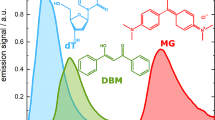Abstract
The effect of high linear energy transfer (LET) radiation on DNAin vitro, both in protective and non-protective environments was investigated. Two hydroxyl radical scavengers, tris(hydroxymethyl) aminomethane and 2-mercaptoethanol, were compared for their ability to protect SV40 DNA from radiation damage over a wide LET range. At comparable OH scavenging capacities, significant differences were found between these protective agents, indicating that other, radical scavenger-dependent processes affected the extent to which the DNA was protected. In general, a decrease in single-strand breaks (SSBs) relative to double-strand breaks (DSBs) was observed as LET increased. This effect was more pronounced when a radioprotector was present. Comparison of the relative biological efficiency (RBE) of radiation damage as LET increased showed a peak of DSB production in the mid-LET range. These data agree with measurements made by Christensen et al. (1972). An explanation for this increase in DSB production efficiency has been proposed based on the particle track structure of high-LET radiation.Correspondence to: G. Taucher-Scholz
Similar content being viewed by others
References
Akhlaq MS, von Sonntag C (1987) Intermolecular H-abstraction of thiyl radicals from thiols and intermolecular complexing of the thiyl radical with the thiol group in 1,4-dithiothreitol. A pulse radiolysis study. Z Naturforsch [C] 42:134–140
Aufderheide E, Rink H, Hieber L, Kraft G (1987) Heavy ion effects on cellular DNA: strand break induction and repair in cultured diploid lens epithelial cells. Int J Radiat Biol 51:779–790
Chatterjee A, Magee JL (1985) Theoretical investigation of the production of strand breaks in DNA by water radicals. Radiat Prot Dosim 13:137–140
Christensen RC, Tobias CA, Taylor WD (1972) Heavy-ion induced single- and double-strand breaks inΦX-174 replicative form DNA. Int J Radiat Biol 22:457–477
Held K, Harrop HA, Michael BD (1984) Effects of oxygen and sulphydryl-containing compounds on irradiated transforming DNA. III. Reaction rates. Int J Radiat Biol 45:627–636
Herskind C (1988) Sulphydryl protection and the oxygen effect on radiation-induced inactivation of r-chromatin in vitro. Influence of an OH scavenger: t-butanol. Radiat Res 115:141–151
Herskind C, Westergaard O (1988) Variable protection by OH scavengers against radiation-induced inactivation of isolated transcriptionally active chromatin: the influence of secondary radicals. Radiat Res 114:28–41
Hicks M, Gebicki JM (1986) Rate constants for reaction of hydroxyl radicals with Tris, Tricine and Hepes buffers. FEBS Lett 199:92–94
Holley WR, Chatterjee A, Magee JL (1990) Production of DNA strand breaks by direct effects of heavy charged particles. Radiat Res 121:161–168
Hubert F, Fleury A, Bimbot R, Gardes D (1980) Range and stopping power tables for 2.5–100 MeV/nucleon heavy ion in solids. Ann Phys Fr 5 [Suppl]:1–214
Jayson GG, Stirling DA, Swallow AJ (1971) Pulse and X-radiolysis of 2-mercaptoethanol in aqueous solution. Int J Radiat Biol 19:143–156
Kampf G, Eichhorn K (1983) DNA strand breakage by different radiation qualities and relations to cell killing. Stud Biophys 93:17–26
Kraft G (1987) Radiobiological effects of very heavy ions: inactivation, induction of chromosome aberrations and strand breaks. Nucl Sci Appl 3:1–28
Kraft G, Kraft-Weyrather W, Ritter S, Scholz M, Stanton J (1989) Cellular and subcellular effect of heavy ions: A comparison of the induction of strand breaks and chromosomal aberrations with the incidence of inactivation and mutation. Adv Space Res 9:59–72
Kraft-Weyrather W, Kraft G, Ritter S, Scholz M, Stanton J (1990) The preparation of biological targets for heavy ion experiments up to 20 MeV/u. Nucl Instrum Methods Phys Res [A] 282:22–27
Krisch RE, Flick MB, Trumbore CN (1991) Radiation chemical mechanisms of single- and double-strand break formation in irradiated SV40 DNA. Radiat Res 126:251–259
Lett JT, Keng PC, Bergtold DS, Howard J (1987) Effects of heavy ions on rabbit tissues: induction of DNA strand breaks in retinal photoreceptor cells by high doses of radiation. Radiat Environ Biophys 26:23–36
O'Neill P, Jenkins TC, Fielden EM (1980) Interaction of oxygen and nitroxyls with radiation - induced radicals of DNA and related bases in aqueous solution. Radial Res 82:55–64
Prütz WA (1989) “Chemical Repair” in irradiated DNA solutions, thiols and/or disulphides. Further evidence for disulphide radical anions acting as electron donors. Int J Radiat Biol 56:21–33
Roots R, Okada S (1975) Estimation of life times and diffusion distances of radicals involved in X-ray induced DNA strand breaks and killing of mammalian cells. Radiat Res 64:306–320
Schäfer A (1991) ESR - Spektroskopische Untersuchungen freier Radikale nach Einwirkung schwerer Ionen auf die DNA. PhD Thesis, Saarbrücken
Taucher-Scholz G, Stanton JA, Schneider M, Kraft G (1991) Induction of DNA breaks in SV40 by heavy ions. Adv Space Res 12(2–3):73–80
Todd P, Tobias CA (1974) Cellular radiation biology. In: Tobias CA, Todd P (eds) Space radiation biology and related topics. Academic Press, New York, p 141
Ward JF (1985) Biochemistry of DNA lesions. Radiat Res 104:103–111
Author information
Authors and Affiliations
Rights and permissions
About this article
Cite this article
Stanton, J., Taucher-Scholz, G., Schneider, M. et al. Protection of DNA from high LET radiation by two OH radical scavengers, tris (hydroxymethyl) aminomethane and 2-mercaptoethanol. Radiat Environ Biophys 32, 21–32 (1993). https://doi.org/10.1007/BF01213127
Received:
Accepted:
Issue Date:
DOI: https://doi.org/10.1007/BF01213127




